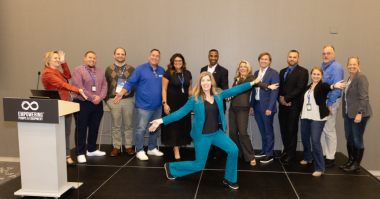Author: Ian Baynes
Building Capacity in an Organization
Companies spend a great deal of time and energy to keep their sales pipelines full, but are they feeding their “employee pipeline”? The mass exodus of retirees has been going on for several years, and they have been taking with them vast amounts of institutionalized knowledge – knowledge that is not written down anywhere, but exists as a result of decades spent working in the industry, learning things that can only be learned by “doing”. Many companies have been so caught up with their loss of talent and struggling to bring in new talent and the costs associated with it, that they have completely forgotten about one of their richest resources – their existing employees.
The sad truth is that many companies only pay attention to employees when that person is hired, when they’re leaving, or at annual performance review time – and then its only to tell them what they need to do better, and not how to grow. In the middle, in the time that really counts, the employee is all too often forgotten about. This broad and deep resource base of existing employees, with a little attention and support from the organization, has the ability to step up to the plate to provide a solution to the building problem of our aging workforce and inability to attract new talent into our not-so-sexy industry.
4 Keys to Building Internal Capacity
Building capacity within an organization does require significant expenditure of time, energy, and of course, money – but the costs associated with externally filling job openings is far greater. For example, how many times has this scenario happened to industrial companies – a senior professional leaves, and the company has to find someone to replace them. That company then spends huge amounts of time and money to bring in someone from the outside into the organization; and even then takes 6-12 months for them to become truly effective in their new role. If that company had instead been working to develop their people internally, utilizing succession plans for key positions, mentoring and training to build capacity in key individuals, and using this to create a succession pool, they would have been prepared for that senior professional’s departure and would have saved the time, energy, and money used to bring in that hard-to-find ‘new’ talent.
It is clear that building capacity INSIDE of an organization is critical to the success of many industrial companies. There are 4 key concepts behind building internal capacity – which ultimately supports company growth over the long-term. These concepts are Succession Planning, Individual Career Planning, Mentoring, and Training. The net benefit to this, apart from creating a pool of talent ready for their next career step, is an engaged workforce with reduced turnover in critical roles and resources.
Succession Planning
Do you know what the critical positions in your company or team are? How many of these critical positions are held by a single person (that has critical or institutionalized knowledge) where no back up exists? How many are held by a person tapped for promotion? How many might be a recognizable flight risk (high probability of exiting the company within the next 1 to 2 years – hired away or fired)? If you answer “NO” to any of these questions, then you probably have a need for a Succession Plan.
At its most basic level, a Succession Plan lists the roles within a given team or organization, gives the name of the incumbent, and then lists the potential replacements for the incumbent should they leave the position. A Succession Plan typically lists 2 to 4 people for each role, naming those ready within the next year, out to those ready within the next 2 to 3 years; identifying them as needing preparation to fill the role in the future. It could also, with some additional thought, identify those who have a desire to fill the role as they see it as the next step on their career path. Its common knowledge that an individual given the chance to prepare for and then fill a role they want to fill, perform at a significantly higher level than those transitioned into the role by their manager; assuming of course they have the right skills and capabilities to perform the identified task – this is where early stage mentoring and training can be used to help identify high potentials vs those with the desire but not the ability.
When done correctly and with well thought out detail, a good Succession Plan will help mitigate much of the risk associated with employee turnover, regardless of whether it is planned or unplanned.
Pro Tip #1: Include the roles you have a vision on needing in the future. This will help with early stage resource planning and skill pipeline development.
Pro Tip #2: Don’t make Succession Plans public knowledge as it creates unnecessary tension and opens questions you are not in a position to answer from those involved. The only people who need to know the detail, apart from your one up and HR, are those in the midst of or preparing for a transition.
Pro Tip #3: Think outside the box and outside of your group. Cross-functional exchanges are truly amazing way to build deep and broad skills, employee capacity, and organizational goodwill. I can speak from personal experience here as I’ve had the opportunity to move laterally and cross-functionally numerous times. The depth and breadth of the skills those experiences gave me continue to carry me through my career today.
Career Development Planning [CDP]
An important point to note here is that the responsibility of a person’s career lies in their hands and not that of an organization or team leader. Our job as leaders is to help them achieve their goals and aspirations or help them understand where their limitations may stop them realizing their goals. For example, I may want to be a jet fighter pilot, but I may not have the necessary critical ability to be one; so it’s important for me to recognize and be carefully and thoughtfully coached to accept my ultimate limitations.
As leaders it is also our responsibility to help them attain the necessary skills, knowledge or training (both internal and external) to help them prepare for the next stage of their career and this is where a well-structured Career Development Plan comes into play. Developed and owned by the individual and shared with their one-up manager, a Career Development Plan looks to capitalize on their individual strengths in order to help them attain their next position and identify areas where training or mentoring will help bridge any identified skill gaps. It is not designed to focus on areas of “performance development – that should be covered by their annual review cycle. Career plans are designed to be a positive forward looking document that energizes the individual and highlights strengths that their company can and should be capitalizing on, with considerations for how to transmit a strength, refine a strength, and ultimately amplify a strength – all to the benefit of the individual, those they work with, and the company as a whole.
Helping an individual recognize their strengths and then capitalizing on those strengths is a very rewarding experience for both the supervisor and the individual in development; it builds tremendous good will around your organization as the individuals feel that you are truly investing in their future.
So how do you identify an individual’s strengths? To identify an individual’s strengths, the best action a company can take is bring in a third party to help – this way, the process is driven by data instead of ‘personal beliefs’. There are a number of great tools that can be used; one example is StrengthFinder 2.0 by Tom Rath.
If we don’t encourage our team members to take control of their career and once in a while “look up” to make sure they are heading in a direction they want to go, then we inadvertently create disgruntled employees who believe their company has no interest in them or their careers. Feelings like this spread both inside and outside of the company.
I cannot stress enough that every person is responsible for their own career, but it’s our role to assist them through their journey. A great mantra that I was taught a few years back is “You Drive, We Assist”, thank you Maureen Crawford Hentz
Mentoring
Mentoring is the process of pairing an individual you would like to develop, or is asking for development with a person who holds specific institutionalized knowledge or experience. The goal is for a knowledge transfer to take place between the mentor and the mentee, along with the guidance on how apply the knowledge. In reality, however, knowledge actually is transferred in both directions as the mentor learns new skills when dealing with individuals who are typically outside of their knowledge or experiences stream. Therefore it is CRITICAL that close attention is paid when pairing a Mentee with their Mentor. If done correctly both parties stand to gain tremendously from the experience. I can speak from personal experience that being a mentor is a rich and rewarding experience and there is no better feeling to see your mentee ‘graduate’ and take the next step on their career journey.
Mentoring programs can span multiple time frames and multiple mentee/mentor pairings – depending on the background, long-term expectation, and skills/knowledge to be gained by the individual[s]. What is clear, though, is that it must be a facilitated and companywide, senior executive level supported program with defined goals that have a measurable outcome as this will help both the mentor and mentee work together and help structure the knowledge transfer. In the case of a mentor being a pending retiree with critical institutionalized knowledge, then timing is another critical factor to be considered. I have seen too many instances when a company suddenly realizes that a person is considering retirement and they have no back up or ability to replace them; at that point, it’s too late. So what do they do? They ask the pending retiree if they would be willing to come back on a part-time consultative basis to ‘help out’ with the transition or while they find their replacement. Now the company’s expenses have substantially increased and the clock is ticking yet again relative to the retiree walking away. All of this risk and additional cost could have been avoided with a Succession Plan and mentoring program with a supporting training program for skills and knowledge, including those that can only be gained externally.
There is a lot of information on how to set-up, run, monitor, and measure the success of mentorship programs, but the purpose of mentioning it here is to show its criticality in the work an organization needs to do to build capacity in its existing workforce to prepare for the future. Without taking these actions, they can expect to see years of knowledge lost as their long-time employees step out into the next phase of their life journey, and the company will only have more costs as they seek to replace them.
A note regarding ‘best practices’: One of the best practices I have witnessed with regards to mentee selection, outside of selection for a specific purpose, was to have people apply to be mentored. Have the people applying to be mentored express their specific skills or knowledge they are passionate about learning. Similarly, ask senior-level professionals inside your organization what they feel they have to offer as a mentor. This allows you to create a pool of interested parties for future reference. Pair your professionals up with clear goals for what the ‘mentee’ should be learning from the ‘mentor’. Monitor the growth and development over time, making sure the mentee is gaining the experience and necessary business skills they were initially looking for. This is more of an ‘ad hoc’ approach, but allows you to pick up on a need identified in the person’s career plan and to use mentoring as a means of providing support so that the skill or knowledge can be gained even though there is no defined next step position in view.
Training
And lastly we come to training, put last because that’s where it belongs in this journey. Too often companies lead with training, thinking that mass ‘reskilling’ and “Death by PowerPoint” will help raise the skill levels of their teams and create a better prepared future pool of resources. The flaw in this thinking is that rarely do they create the environment for those newly attained skills or knowledge to be used and flourish. Then, with nowhere to go, they invariably are quickly lost and, sadly, all that invested time and money is wasted.
Now let’s rethink the role of training and our goal of building capacity within an organization to help offset the issues seen with workforce turnover and also the difficulties realized in trying to find suitable replacements.
We started this discussion talking about Succession Planning then Career Development Plans, and lastly mentoring. What if training was used in support of this? What if the training identified for an individual was based on their aspirations, the needs of the company, and the skill gaps identified in their CDP and mentee activities? How much more value is created through training then? When there is a mutually agreed upon purpose and a clearly defined end game for training, both the individuals and the companies involved see a higher return on the invested time AND the ability of the individual to actually use the attained skills is greatly increase, which also benefits both parties.
When a company takes the time to construct a training program for an individual that is based on their career aspirations, company needs, and the skills they need to attain, then the value of the training is significantly increased as is its overall impact on the individual and company as a whole.
It’s very important that you take the time to evaluate your company’s training programs and practices. They differ drastically from company to company and skill to skill, but what is common is the need to employ current best practices to ensure increased knowledge and skill retention rates. At the beginning of this article, I referenced the 70/20/10 rule which is based on the simple fact that people learn quicker and retain more information when the majority of it comes from hands-on practical experience, and next from learning from others (mentoring, peer-to-peer networking), and finally classroom time.
Read Part 1 of this 2-Part Series.
About the Author
 Ian Baynes is a Strategy Guy, Guitar Making, music loving, martini enthusiast with a passion for developing people and business.
Ian Baynes is a Strategy Guy, Guitar Making, music loving, martini enthusiast with a passion for developing people and business.
With a career spanning more than 25 years in global business development and strategic marketing, spanning both the automotive and industrial worlds, Ian has a proven track record for identifying and managing businesses and services in both emerging and large established markets, and has extensive experience in Europe, North America, and Asia.
Specializing in Strategic Business Planning and Execution Ian has helped numerous companies and organizations develop their long term business development growth plans as well as helping them increasing organization capacity to support its execution.
Areas of expertise:
- Global Business Development
- Strategic Business Planning and Execution
- Classic Marketing
- Brand Strategy Development
- Resource Planning
- Industrial Market and Sales Channel Development
- E-Marketing and Social Media
- Product Development and Life Cycle Management






Comments